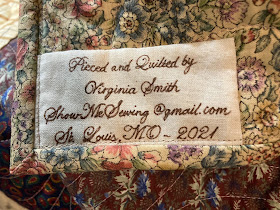I was asked how I did quilt labels. Quilt labels come in many shapes and sizes with minimal to a lot of information on them. I have tried different ways, and this is the way I revert back to in most cases. However, for privacy reasons don't feel I can show some of my better labels since they have the persons' names on them and I have not asked permission to post them.
I almost always put my labels on the back of the bottom right side of the quilt, which means the quilts above, I did on the wrong side. But it shows a very simple label hand sewn a short distance from the binding which is what I wanted you to see.
For more special quilts, I will frame the label, either with fabric (as shown in these two eagle quilt labels) or with a frame drawn on the label.
Still other times, I have made the label and sewn it on the quilt back before I do the quilting. This has the advantage that there is no hand sewing (which I dislike). But it has the distinct disadvantage of putting the label in the wrong place. I have made the mistake of carefully placing my label, then loading the quilt incorrectly which put the label sideways on the top left side. And of course it was done before the quilting, so there is no easy way to take it off and put it on again. Again, good if you don't want it removed, and bad if you made a mistake. In the case of the one pictured below, it is facing the right way, and nicely sewn and quilted down, but I would have preferred for it to be closer to the bottom of the quilt.

So, here is my tried and true method. I start by typing it up on the computer. I can spell check, edit, change fonts and do whatever I need to do so it looks the way I want. Remember to have at the very least, who made the quilt, who quilted it, where and when. Adding the why, name of pattern, etc. are nice and helpful for the quilt historians.
Then, using a light table/box and fabric markers, I trace the information on usually white or off white cotton fabric. Little tiny pieces of tape help hold things in place while this is done. You can also stick the tape first to your clothes before using it, so it doesn't stick so fast you fray the edge of your label when pulling the tape off.
Now cut it to size. I allow 1/2" from all sides of the writing which will leave, once seams are taken, 1/4" margin. As you cut, not only line up with the writing, but also the already cut edges so you have it squared.
Then press the edges. If you followed my measurements above, you shouldn't need an ruler to iron. Just fold the raw edges up to the edge of the writing and that should be your 1/4" seam allowance.
Press. You also want the heat of the iron to set the ink on the writing, so make sure in the end to press the whole thing. In some cases, you want all 4 sides turned under (like all the labels at the beginning of the post). Those will look like the one on the far left here.
But some you might want to sew in such a way that the binding catches 2 of the sides as I will show you below. If so, you will want to press only the top and right side of the label (as shown in the right 2 tan labels).
The label with only two sides ironed under will be place to the edge, or 1/8" from the bottom left-hand corner of the back of the quilt (which will be the back of the bottom right). Since I use a 2-1/2" double fold binding, I place the label 1/8" from the edge so when I sew the binding down at 3/8," it will only cover 1/4" of the label, keeping the words centered. I suppose I could cut the label with a little more room on the bottom and left sides to compensate, but this works best for me.
I then hand sew the two folded under edges to the quilt as invisibly as possible. My favorite stitch is the ladder stitch. Yes, I am a lefty, so I start from the left and sew right. If you are right handed, you will obviously want to start on the right and sew left.
Here, I'm trying to show that to hide the stitching as well as you can, where the last stitch ended on one side is where the stitch on the other side begins. Take little stitches. How big? I have always tried to imitate the size of stitch the sewing machine takes so it holds fast.
My preference has always been to sew the binding to the back of the quilt, fold to the front and carefully stitch right near the edge of the fold on the binding. I feel I make it look better that way than any other way I've tried, and I have tried many other ways. Yes, there is stitching near the binding on the back of the quilt, but I find that less distracting than sewing the binding to the front, folding over and stitching in the ditch on the front and ending up with varying between a nice stitch on the back with missing the binding in places and having too much of a seam in other places. That method looks more wobbly to me, so I'll stick with this.




















































